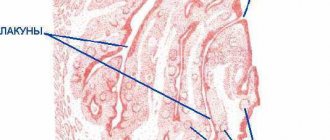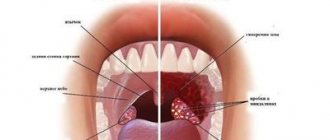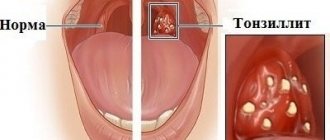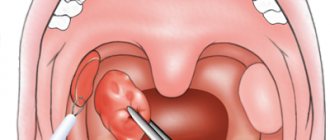Holes in the tonsils: what are they?
Normally, in a healthy person, the tonsils are structured like a porous sponge and contain approximately 20 depressions (lacunae), which are designed to contain pathogens.
During illness, this first line defense mechanism prevents the infection from progressing further. Microbes settle in the gaps - clots of white or yellow pus become noticeable on the tonsils; by the way, these are the only tonsils in the body that you can see for yourself.
This organ has the ability to recover on its own and after treatment, the tonsils take on their previous appearance, becoming whole, dense, covered with pale pink mucous.
Holes in the tonsils: photo
In the case of frequent illnesses, complications, or reduced immunity, this process is disrupted and the lacunae are closed with degenerated lymphatic tissue, which visually looks like holes in the palatine tonsils. These holes become collections for food debris, bacteria, and dead epithelial cells, which form purulent plugs.
When asked what kind of holes are in the tonsils, the doctor diagnoses the patient with chronic tonsillitis.
Possible complications
Holes in the tonsils can cause purulent tonsillitis. This disease occurs due to the accumulation of different types of bacteria and viruses in enlarged lacunae. The pathology is severe and is accompanied by the following symptoms:
- temperature increase to +38…+40 degrees;
- enlarged cervical lymph nodes;
- severe sore throat, worsening when swallowing;
- swelling and redness of tissue in the throat;
- weakness, general malaise.
Photos of holes in the tonsils with purulent tonsillitis can be seen below.
Also, bacteria and viruses from lacunae can enter the bloodstream and spread to various organs. This causes secondary infectious pathologies:
- cystitis;
- pneumonia;
- gastritis;
- sepsis;
- meningitis;
- arthritis.
To avoid such severe consequences, it is necessary to promptly treat chronic inflammation of the tonsils.
What are the symptoms?
In addition to visual identification, holes in the tonsils are accompanied by other symptoms that should alert you. These include:
- swelling of the palatine tonsils;
- sensation of a foreign body in the throat;
- discomfort when swallowing, inability to perform a full act of swallowing;
- expectoration of white lumps (caseous plugs);
- foul breath that cannot be masked by anything;
- elevated body temperature (sometimes).
Together, these symptoms indicate the development of an inflammatory process in the throat.
Causes of holes in tonsils
Holes in the tonsils cannot just happen. Their appearance means an active increase in lymphocytes (the body's defenders), in tissue cells that begin to divide and grow.
As a result, the tonsils acquire a loose, deformed structure. The reasons why holes remain after traffic jams include:
- bacterial infections. Due to the proliferation of microbes, the lymphatic tissue of the tonsils becomes swollen, which leads to the expansion of natural lacunae;
- rehabilitation period after illness. The tonsils need some time to recover in size after suffering a viral disease;
- frequent hypothermia;
- enlarged nasopharyngeal tonsils (adenoids). This pathology is accompanied by a chronic inflammatory process;
- inflammation of the maxillary sinuses, which is characterized by the accumulation of large amounts of pus;
- dental diseases;
- dental infections of the oral cavity – stomatitis, inflammation of the tongue, gingivitis;
- congenital or acquired deformation of the nasal septum.
When the throat hurts very badly and holes in the tonsils, which are filled with pus, appear as a result of lacunar tonsillitis.
All these factors significantly reduce the body’s defenses, as a result of which the tonsils, being the center of attack of pathogenic bacteria, become deformed.
Prevention
How to prevent the expansion of lacunae and the appearance of plugs in the throat? Otolaryngologists advise adhering to the following recommendations:
- Maintain good oral and throat hygiene. It is necessary to regularly brush your teeth and rinse after meals. This will help clear your mouth of food debris that may settle on your tonsils.
- Stop smoking. Tobacco smoke irritates the tonsils. This can cause inflammation of the tonsils and expansion of the lacunae.
- Don't get too cold. Excessive exposure to cold leads to a weakened immune system and sore throat.
It is also very important to cure colds and inflammatory pathologies of the ENT organs in a timely manner. These diseases should not be allowed to become chronic. Constant inflammation of the throat is one of the main reasons for the appearance of holes and plugs, which can sometimes be difficult to get rid of.
Do I need to see a doctor?
If, with the help of a mirror, a hole was discovered in the tonsil, and there is pus inside, this is a serious reason to consult a doctor, since in this way only a small part of the inflammatory process can be seen.
Moreover, it is categorically impossible to remove these accumulations of pus on your own - even the slightest damage to the lymphoid tissue can provoke the spread of infection throughout the body, including blood poisoning.
Cases where there are holes in the tonsils, but they are without pus, should not be ignored by doctors either. The presence of such a deformation indicates the absence of a natural barrier to infections and is a favorable environment for the free proliferation of pathogenic microbes.
First, you can seek help from a general practitioner, who, if necessary, will refer the patient to specialized specialists - an otolaryngologist or an ENT surgeon.
Methods for diagnosing pathology
At the appointment, the doctor examines the tonsils using a laryngeal mirror, a magnifying glass and a light source, collects anamnesis, and states the general condition.
Additionally, he examines the nasal cavity and auditory canals. To make a diagnosis and identify concomitant diseases, the doctor gives directions for laboratory and diagnostic tests:
- General and biochemical blood test. Indicators of the levels of red blood cells, leukocytes and platelets will help determine the presence of an inflammatory process or any neoplasms;
- general urine analysis. Necessary for detecting pathological processes in the body that reduce immunity and worsen the patient’s condition;
- smear for bacterial culture. Epithelial cells of the pharynx will help determine the type of pathogenic organisms, which will help in choosing the right therapeutic tactics.
Bacterial studies are carried out with a button probe, which is inserted to determine the presence of adhesions characteristic of chronic tonsillitis.
If a malignant neoplasm is suspected, a biopsy of the lymphoid tissue of the throat is performed.
Treatment of tonsils in pus
About tonsils
Tonsils are one of the most important immune organs that prevent pathogenic masses from entering the body, preventing their penetration at the stage of penetration into the oral cavity. The palatine tonsils are a paired organ of the immune system, which are an accumulation of lymphoid tissue in small formations. In general, the tonsils are divided into palatine, tubal, pharyngeal and lingual and together form the lymphatic pharyngeal ring, which in medicine is also called the Pirogov-Waldeyer lymphoid ring.
Normally, when foreign microorganisms enter, the tonsils come into action, secrete immune cells and suppress the attachment and development of pathogenic flora. However, in the presence of certain causes and factors, one of which is a weakening of the immune system in general, for example, against the background of a cold, hypothermia, etc., they become unable to protect themselves, which leads to an inflammatory process on their surface, in the oropharynx area . Against the background of inflammation of the tonsils, purulent formations, like films or plugs, may appear on their surface.
In this case, it is urgent to take specific treatment measures that will be aimed at eliminating inflammation and normalizing the functioning of the tonsils. To do this, you should contact ENT doctors who will quickly eliminate the symptoms of the disease and, most importantly, take preventive measures to prevent relapses of the disease in the future.
Causes of pus in the tonsils
The causes of pus in the tonsils boil down to the fact that, against the background of various damaging factors, the body’s immune defense is reduced, which leads to the addition of a bacterial infection and the settling of pathogenic bacteria on the tonsils. This situation is accompanied by the appearance of pus on the tonsils, as well as the development of the inflammatory process.
Among the very factors that can lead to the appearance of pus on the tonsils are:
- Vulgar or ordinary sore throat, as a result of aggression of opportunistic flora due to weakened immunity as a result of hypothermia, stress, exposure to cold drinks and a number of other reasons
- Sore throat due to infectious diseases such as mononucleosis, scarlet fever, etc.
- Chronic tonsillitis, in which the lacunae of the palatine tonsils are often filled with a characteristic purulent cheesy discharge
- Sore throat in systemic blood diseases (leukemia, agranulocytosis).
- Ulcerative-necrotic tonsillitis (ulcerative-membranous, Simanovsky-Plaut-Vincent tonsillitis, fusospirochetous tonsillitis) is caused by a symbiosis of the fusiform bacillus (Bac. fusiformis) and the oral spirochete (Spirochaeta buccalis).
- Constant stress, bad habits, climate change, unbalanced diet, lack of sports in everyday life - all this also leads to a decrease in immunity, which means it can trigger the appearance of purulent tonsils.
Symptoms of pus in the tonsils
Symptoms of pus in the tonsils are characterized by the following:
- A sore throat appears, which is especially severe when swallowing food and talking;
- There is an unpleasant odor from the mouth;
- There is a sore throat;
- There is a sensation of a foreign body in the throat;
- There are enlarged submandibular and cervical lymph nodes;
- There is a deterioration in general health and an increase in body temperature.
If you have the above symptoms and if you suspect the presence of pus in the tonsils, we remind you once again: it is imperative to consult an ENT doctor to establish an accurate diagnosis and choose treatment tactics.
Treatment of tonsils in pus
Treatment of tonsils with pus must be immediate, qualified and of high quality. Otherwise, the disease will return to the patient after some time, but will manifest itself in a more severe form and, possibly, lead to the development of serious complications. Treatment of tonsils with pus in our specialized clinic takes place after consultation with a specialist. This makes it possible to make a correct diagnosis and determine the scope of treatment, which includes exclusively individual selection of therapy.
Doctors at our clinic offer only proven and effective methods for treating tonsils with pus:
- In first place, as the choice of treatment method for purulent tonsils, is deep vacuum ultrasound sanitation. This method is highly effective even in the treatment of chronic forms of the disease. Elimination of pus on the tonsils is carried out using a procedure in which they are exposed to ultrasound. Ultrasound, as it were, destroys purulent plugs and promotes their painless detachment from the tonsils and leaving the oral cavity. In addition, this method of sanitation of tonsils from pathogenic formations is absolutely safe and well tolerated by patients, and its results are noticeable after the first procedure.
- Photodynamic therapy is also used to treat tonsils. Its action is aimed at activating regenerative processes in the mucous membrane of damaged tonsils, which leads to their rapid restoration and elimination of inflammation and purulent formations. Photodynamic therapy is a modern treatment method that painlessly eliminates the inflammatory process and improves the patient’s condition, returning him to a normal lifestyle in the shortest possible time.
- Other effective and unique techniques are used to treat tonsils with pus. One of them is ozone therapy. Ozone therapy allows you to sanitize the tonsils from pathogenic microorganisms that led to the formation of pus. This cleansing of the tonsils from pathogens is very gentle and effective.
Remember, the treatment of tonsils with pus in our clinic is carried out by the best ENT doctors, which means it is as effective, safe and of high quality as possible!
Treatment methods
You can get rid of holes in the tonsils filled with pus only by eliminating the true cause of the inflammatory process. Self-medication in such cases is contraindicated, since only an experienced doctor will be able to provide complex therapy, minimizing serious complications.
Taking antibiotics
When pus accumulates in the lacunae, broad-spectrum antibacterial drugs are used, which not only inhibit the proliferation of bacteria, but also completely destroy them. Depending on the type of pathogenic pathogens, drugs such as Azithromycin, Tsiprolet, Amoxicillin are prescribed.
Washing tonsils in the ENT office
To clean them of purulent plugs, a syringe with a special attachment is used, which directs the disinfectant composition directly into the lacunae. A jet under pressure knocks out the plugs, and the tonsils are cleared. For full results, at least 15 sessions are required.
Vacuum lavage of the tonsils is carried out under local anesthesia using a device. A special nozzle is attached to the tonsil, and the purulent contents are sucked out through it. The tonsils are then treated with an antiseptic to prevent relapse.
Another device, Tonsilor, is actively used by doctors to treat purulent tonsils. The impact on the tonsils is carried out using ultrasound and vibrations transmitted by a special attachment. When the purulent plug becomes pliable, it is washed out with a medicinal solution, which is delivered in a strong stream.
Physiotherapy
The most popular and effective procedures are using:
- ultraviolet rays, which have a powerful antibacterial effect;
- laser, which activates blood and lymph flow in the tonsils, relieves inflammation;
- ultrasound, with the help of which medications penetrate deep into the tissue of the tonsils.
Also, throughout the entire treatment, the doctor prescribes rinsing the mouth and throat with antiseptic solutions (Furacilin, Miramistin), taking immunostimulating drugs, and vitamin complexes.
Physiotherapy
Drug therapy and throat lavage are supplemented with physiotherapy. When the lacunae on the tonsils expand, the following procedures are prescribed:
- Ultraviolet irradiation. This treatment method helps destroy bacteria in the throat.
- Laser therapy. This physiotherapy stimulates blood circulation and lymph flow in the tonsils. This helps relieve inflammation and swelling.
- Ultrasound with medications on the tonsil area. With this method of administration, the active components of the drugs penetrate deep into the throat tissue.
How to treat at home?
Trying to remove purulent plugs at home is not worth it because of the huge risk of complications. However, for disinfection and strengthening local immunity, traditional medicine recipes can be useful. Suitable for rinsing:
- decoction of onion peels. It must be washed, poured with a small amount of water, brought to a boil and simmered over low heat for 5-7 minutes. Then let the broth brew for at least 3 hours. Use warm;
- beet juice. The root vegetable, crushed in a blender, is sprinkled with table vinegar and left on the table for several hours. Then the juice is squeezed out of the grounds and gargled with it;
- herbal infusion. Pour dry raw materials of chamomile, calendula and plantain into a thermos, pour boiling water over everything and leave to steep for several hours. Gargle after every meal;
- soda-salt solution. Dissolve a teaspoon of salt and soda in a glass of water, mix and use several times a day. The solution has a powerful antiseptic effect.
Rinsing should be done with your head thrown back so that the medicinal composition affects the tonsils as far as possible. The duration of each rinse should be at least 20 seconds.
Cauterization methods
| Method | What is used | Advantages | Flaws |
| Cryotherapy | A liquid nitrogen. Under the influence of liquid nitrogen, the tissue is greatly cooled. Ice crystals form inside the cells, destroying the cell wall. | Bloodless, painless method. Well tolerated by elderly patients. | To achieve a lasting effect, a course of procedures is required. |
| Laser ablation | CO2 laser, holminium or fiber optic laser. The effect is based on the evaporation of liquid (coagulation) of tissue due to laser heating. | Bloodless, painless method. | Heating of the tissues surrounding the tonsil, the formation of a layer of dead tissue, which disappears within 5-7 days. Within 2-3 days after the procedure, discomfort in the throat, similar to a cold. |
| Radio wave ablation | Alternating high-frequency current (radiosurgery devices Surgitron, Curis). The effect is achieved by heating the tissue and evaporating liquid from it. | Bloodless, painless method, good wound healing, gentle effect on surrounding tissues. The procedure is carried out once, and can be repeated after several years. | The formation of a layer of dead tissue, which disappears within 5-7 days; the next day after the procedure, discomfort in the throat, similar to a cold. |
What can be dangerous: possible complications
If tonsils with holes are ignored, the consequences can be very serious and even life-threatening. It's all about the high risk of infection getting from purulent lacunae into the blood. This can cause the following complications:
- cystitis;
- inflammatory process in the kidneys;
- persistent sore throat;
- toothache;
- pathological processes in the nasopharynx;
- inflammation of the respiratory tract;
- problems with the gastrointestinal tract;
- meningitis.
Purulent tonsils, as a constant source of infection, are very dangerous due to their close connection with the digestive, respiratory and circulatory systems.
Untimely and incorrect treatment can lead to an increase in the number of holes in the tonsils and an increase in the inflammatory process. [ads-pc-1][ads-mob-1]
When is surgery needed? Surgical removal
Removal surgery is needed only if their tissues are irreversibly atrophied, and constant sore throats seriously undermine the body. The surgical procedure is performed under local anesthesia or general anesthesia and gets rid of caseous plugs forever. Rehabilitation takes place in a hospital under the supervision of a doctor and takes up to 6 days.
Another method of removing tonsils is cryodestruction. When exposed to low temperatures with the help of liquid nitrogen, the tonsils are completely destroyed. The procedure is performed under local anesthesia and takes only a few minutes. Hospitalization after manipulation is not required.
More on the topic: White spots on the throat: causes and treatment. If they don't pass
How to treat purulent plugs in the throat? Causes of formation and symptoms
Indications for cauterization of tonsils
The surface of the tonsil has depressions - lacunae, they are needed to increase the area of the “working” surface. Allergens and microbial agents, when they enter the mucous membrane, cause an immune response from the body. Chronic inflammation leads to the formation of non-functional scar tissue, the lacunae narrow, and their drainage is impaired. All this leads to the accumulation of caseous plugs in the lacunae. If there are no indications for complete removal of the tonsils, then conservative treatment is carried out: washing the lacunae, physiotherapy. However, soon the lacunae are again “clogged” with plugs and the symptoms of the disease make themselves felt. To improve the functioning of the tonsil, it is recommended to carry out cauterization (ablation). The essence of this procedure is that the superficial layer of the tonsil is bloodlessly removed using a laser or radio wave. After this procedure, purulent plugs do not accumulate in the gaps, their size is reduced, the surface becomes smoother, and inflammation decreases. This way it is possible to achieve stable remission of the disease.









